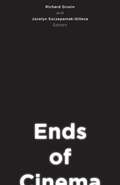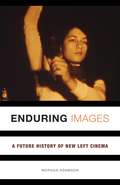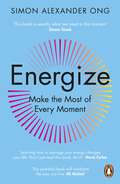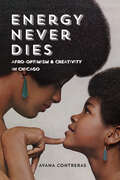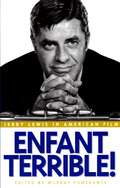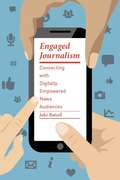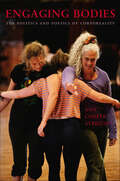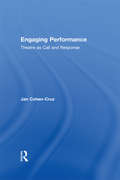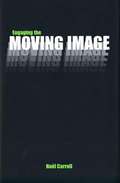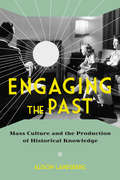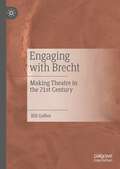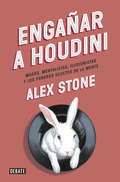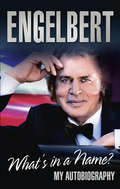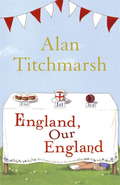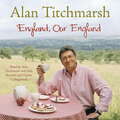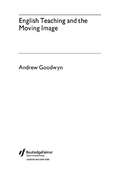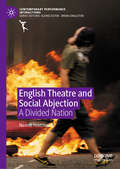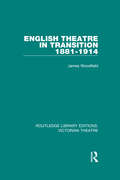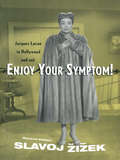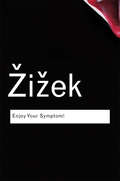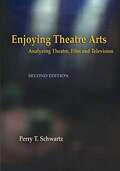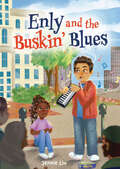- Table View
- List View
Endless Intervals: Cinema, Psychology, and Semiotechnics around 1900
by Jeffrey West KirkwoodRevealing cinema&’s place in the coevolution of media technology and the humanCinema did not die with the digital, it gave rise to it. According to Jeffrey West Kirkwood, the notion that digital technologies replaced analog obscures how the earliest cinema laid the technological and philosophical groundwork for the digital world. In Endless Intervals, he introduces a theory of semiotechnics that explains how discrete intervals of machines came to represent something like a mind—and why they were feared for their challenge to the uniqueness of human intelligence.Examining histories of early cinematic machines, Kirkwood locates the foundations for a scientific vision of the psyche as well as the information age. He theorizes an epochal shift in the understanding of mechanical stops, breaks, and pauses that demonstrates how cinema engineered an entirely new model of the psyche—a model that was at once mechanical and semiotic, discrete and continuous, physiological and psychological, analog and digital.Recovering largely forgotten and untranslated texts, Endless Intervals makes the case that cinema, rather than being a technology assaulting the psyche, is in fact the technology that produced the modern psyche. Kirkwood considers the ways machines can create meaning, offering a fascinating theory of how the discontinuous intervals of soulless mechanisms ultimately produced a rich continuous experience of inner life.
Ends of Cinema (21st Century Studies)
by Richard Grusin Jocelyn Szczepaniak-GilleceAt the dawn of the digital era in the final decades of the twentieth century, film and media studies scholars grappled with the prospective end of what was deemed cinema: analog celluloid production, darkened public movie theaters, festival culture. The notion of the &“end of cinema&” had already been broached repeatedly over the course of the twentieth century—from the introduction of sound and color to the advent of television and video—and in Ends of Cinema, contributors reinvigorate this debate to contemplate the ends, as well as directions and new beginnings, of cinema in the twenty-first century.In this volume, scholars at the forefront of film and media studies interrogate multiple potential &“ends&” of cinema: its goals and spaces, its relationship to postcinema, its racial dynamics and environmental implications, and its theoretical and historical conclusions. Moving beyond the predictable question of digital versus analog, the scholars gathered here rely on critical theory and historical research to consider cinema alongside its media companions: television, the gallery space, digital media, and theatrical environments. Ends of Cinema underscores the shared project of film and media studies to open up what seems closed off, and to continually reinvent approaches that seem unresponsive. Contributors: Caetlin Benson-Allott, Georgetown U; James Leo Cahill, U of Toronto; Francesco Casetti, Yale U; Mary Ann Doane, U of California Berkeley; André Gaudreault, U de Montréal; Michael Boyce Gillespie, City College of New York; Mark Paul Meyer, EYE Filmmuseum; Jennifer Lynn Peterson, Woodbury U, Los Angeles; Amy Villarejo, Cornell U.
Enduring Images: A Future History of New Left Cinema
by Morgan AdamsonAn integrated look at the political films of the 1960s and &’70s and how the New Left transformed cinema A timely reassessment of political film culture in the 1960s and &’70s, Enduring Images examines international cinematic movements of the New Left in light of sweeping cultural and economic changes of that era. Looking at new forms of cinematic resistance—including detailed readings of particular films, collectives, and movements—Morgan Adamson makes a case for cinema&’s centrality to the global New Left. Enduring Images details how student, labor, anti-imperialist, Black Power, and second-wave feminist movements broke with auteur cinema and sought to forge local and international solidarities by producing political essay films, generating new ways of being and thinking in common. Adamson produces a comparative and theoretical account of New Left cinema that engages with discussions of work, debt, information, and resistance. Enduring Images argues that the cinemas of the New Left are sites to examine, through the lens of struggle, the reshaping of global capitalism during the pivotal moment in which they were made, while at the same time exploring how these movements endure in contemporary culture and politics. Including in-depth discussions of Third Cinema in Argentina, feminist cinema in Italy, Newsreel movements in the United States, and cybernetics in early video, Enduring Images is an essential examination of the political films of the 1960s and &’70s.
Energize: Make the Most of Every Moment
by Simon Alexander OngWinner of the 2023 Business Book Award for Wellness and Wellbeing'This book is exactly what we need in this moment' Simon Sinek, author of Start With Why'Learning how to manage your energy changes your life. Don't just read this book, do it!' Marie Forleo, author of Everything is FigureoutableIn Energize, award-winning life coach Simon Alexander Ong introduces you to the art and science of energy management. In a world where we are always on, Ong coaches you to work with your natural energy resources to recognize your most energized state - when to push and when to recoup - so that you can work sustainably towards your biggest goals.You'll learn how to:- Speak less and listen more- Stop treating your health as a side hustle- Silence your inner critic and listen to your inner guide instead- Progress faster by saying no to the activities that are holding you backIt's time to find out what you can achieve when you feel energized.'Simon provides practical advice to help you achieve your full potential in every area of your life. Exceptional!' Dr Marshall Goldsmith, author of Triggers'Learning how to energize ourselves is key to being happy and successful' Shaa Wasmund MBE, author of How to Fix Your Sh*t
Energy Never Dies: Afro-Optimism and Creativity in Chicago
by Ayana ContrerasFrom Afro Sheen to Theaster Gates and from Soul Train to Chance the Rapper, Black Chicago draws sustenance from a culture rooted in self-determination, aspiration, and hustle. In Energy Never Dies, Ayana Contreras embarks on a journey to share the implausible success stories and breathtaking achievements of Black Chicago's artists and entrepreneurs. Past and present generations speak with one another, maintaining a vital connection to a beautiful narrative of Black triumph and empowerment that still inspires creativity and pride. Contreras weaves a hidden history from these true stories and the magic released by undervalued cultural artifacts. As she does, the idea that the improbable is always possible emerges as an indestructible Afro-Optimism that binds a people together. Passionate and enlightening, Energy Never Dies uses the power of storytelling to show how optimism and courage fuel the dreams of Black Chicago.
Enfant Terrible!: Jerry Lewis in American Film
by Jerry LewisThe one thing everybody knows about Jerry Lewis is that he is beloved by the French, those incomprehensible hedonistic strangers across the sea. The French understand him, while in the U.S. he is at best a riddle, not one of us. Lewis is someone we take profound pleasure in excluding, if not ridiculing. Enfant Terrible! Jerry Lewis in American Film is the first comprehensive collection devoted to one of the most controversial and accomplished figures in twentieth-century American cinema. A veteran of virtually every form of show business, Lewis's performances onscreen and the motion pictures he has directed reveal significant filmmaking talents, and show him to be what he has called himself, a "total filmmaker." Yet his work has been frequently derided by American critics. This book challenges that easy reading by taking a more careful look at Lewis's considerable body of work onscreen in 16 diverse and penetrating essays. Turning to such films asThe Nutty Professor, The Ladies Man, The King of Comedy, The Delicate Delinquent, Living It Up, The Errand Boy, The Disorderly Orderly, Arizona Dream, and The Geisha Boy, the contributors address topics ranging from Lewis's on- and offscreen performances, the representations of disability in his films, and the European obsession with Lewis, to his relationship with Dean Martin and Lewis's masculinity. Far from an out of control hysteric, Enfant Terrible! instead reveals Jerry Lewis to be a meticulous master of performance with a keen sense of American culture and the contemporary world. Contributors include: Mikita Brottman, Scott Bukatman, David Desser, Leslie A. Fiedler, Craig Fischer, Lucy Fischer, Krin Gabbard, Barry Keith Grant, Andrew Horton, Susan Hunt, Frank Krutnik, Marcia Landy, Peter Lehman, Shawn Levy, Dana Polan, Murray Pomerance, and J. P. Telotte.
Engaged Journalism: Connecting with Digitally Empowered News Audiences
by Jake BatsellExplores the changing relationship between news producers and audiences and the methods journalists can use to secure the attention of news consumers.
Engaging Bodies: The Politics and Poetics of Corporeality
by Ann Cooper AlbrightWinner of the Selma Jeanne Cohen Prize in Dance Aesthetics (2014)For twenty-five years, Ann Cooper Albright has been exploring the intersection of cultural representation and somatic identity in dance. For Albright, dancing is a physical inquiry, a way of experiencing and participating in the world, and her writing reflects an interdisciplinary approach to seeing and thinking about dance. In her engagement as both a dancer and a scholar, Albright draws on her kinesthetic sensibilities as well as her intellectual knowledge to articulate how movement creates meaning. Throughout Engaging Bodies movement and ideas lean on one another to produce a critical theory anchored in the material reality of dancing bodies. This blend of cultural theory and personal circumstance will be useful and inspiring for emerging scholars and dancers looking for a model of writing about dance that thrives on the interconnectedness of watching and doing, gesture and thought.Hardcover is un-jacketed.
Engaging Performance: Theatre as call and response
by Jan Cohen-CruzEngaging Performance: Theatre as Call and Response presents a combined analysis and workbook to examine "socially engaged performance." It offers a range of key practical approaches, exercises, and principles for using performance to engage in a variety of social and artistic projects. Author Jan Cohen-Cruz draws on a career of groundbreaking research and work within the fields of political, applied, and community theatre to explore the impact of how differing genres of theatre respond to social "calls." Areas highlighted include: playwrighting and the engaged artist theatre of the oppressed performance as testimonial the place of engaged art in cultural organizing the use of local resources in engaged art revitalizing cities and neighborhoods through engaged performance training of the engaged artist. Cohen-Cruz also draws on the work of major theoreticians, including Bertolt Brecht, Augusto Boal, and Doreen Massey, as well as analyzing in-depth case studies of the work of US practitioners today to illustrate engaged performance in action. Jan Cohen-Cruz is director of Imagining America: Artists and Scholars in Public Life. She is the author of Local Acts: Community-based Performance in the US; the editor of Radical Street Performance; co-editor, with Mady Schutzman, of Playing Boal: Theatre, Therapy, Activism and A Boal Companion; and a University Professor at Syracuse University.
Engaging the Moving Image
by Noël CarrollNoël Carroll, a brilliant and provocative philosopher of film, has gathered in this book eighteen of his most recent essays on cinema and television--what Carroll calls "moving images." The essays discuss topics in philosophy, film theory, and film criticism. Drawing on concepts from cognitive psychology and analytic philosophy, Carroll examines a wide range of fascinating topics. These include film attention, the emotional address of the moving image, film and racism, the nature and epistemology of documentary film, the moral status of television, the concept of film style, the foundations of film evaluation, the film theory of Siegfried Kracauer, the ideology of the professional western, and films by Sergei Eisenstein and Yvonne Rainer. Carroll also assesses the state of contemporary film theory and speculates on its prospects. The book continues many of the themes of Carroll's earlier work Theorizing the Moving Image and develops them in new directions. A general introduction by George Wilson situates Carroll's essays in relation to his view of moving-image studies.
Engaging the Past
by Alison LandsbergReading films, television dramas, reality shows, and virtual exhibits, among other popular texts, Engaging the Past examines the making and meaning of history for everyday viewers. Contemporary media can encourage complex interactions with the past that have far-reaching consequences for history and politics. Viewers experience these representations personally, cognitively, and bodily, but, as this book reveals, not just by identifying with the characters portrayed.Some of the works considered in this volume include the films Hotel Rwanda (2004), Good Night and Good Luck (2005), and Milk (2008); the television dramas Deadwood, Mad Men, and Rome; the reality shows Frontier House, Colonial House, and Texas Ranch House; and The Secret Annex Online, accessed through the Anne Frank House website, and the Kristallnacht exhibit, accessed through the Unites States Holocaust Museum website. These mass cultural texts cultivate what Alison Landsberg calls an "affective engagement" with the past, tying the viewer to an event or person and fostering a sense of intimacy that does more than transport the viewer back in time. Affect, she suggests, can also work to disorient the viewer, forcibly pushing him or her out of the narrative and back into his or her own body. By analyzing these specific popular history formats, Landsberg shows the unique way they provoke historical thinking and produce historical knowledge, prompting a reconsideration of what constitutes history and an understanding of how history works in the contemporary mediated public sphere.
Engaging the Past: Mass Culture and the Production of Historical Knowledge
by Alison LandsbergReading films, television dramas, reality shows, and virtual exhibits, among other popular texts, Engaging the Past examines the making and meaning of history for everyday viewers. Contemporary media can encourage complex interactions with the past that have far-reaching consequences for history and politics. Viewers experience these representations personally, cognitively, and bodily, but, as this book reveals, not just by identifying with the characters portrayed. Some of the works considered in this volume include the films Hotel Rwanda (2004), Good Night and Good Luck (2005), and Milk (2008); the television dramas Deadwood, Mad Men, and Rome; the reality shows Frontier House, Colonial House, and Texas Ranch House; and The Secret Annex Online, accessed through the Anne Frank House website, and the Kristallnacht exhibit, accessed through the Unites States Holocaust Museum website. These mass cultural texts cultivate what Alison Landsberg calls an "affective engagement" with the past, tying the viewer to an event or person and fostering a sense of intimacy that does more than transport the viewer back in time. Affect, she suggests, can also work to disorient the viewer, forcibly pushing him or her out of the narrative and back into his or her own body. By analyzing these specific popular history formats, Landsberg shows the unique way they provoke historical thinking and produce historical knowledge, prompting a reconsideration of what constitutes history and an understanding of how history works in the contemporary mediated public sphere.
Engaging with Brecht: Making Theatre in the Twenty-first Century
by Bill GelberThis book makes the case for Bertolt Brecht’s continued importance at a time when events of the 21st century cry out for a studied means of producing theatre for social change. Here is a unique step-by-step process for realizing Brecht’s ways of working onstage using the 2015 Texas Tech University production of Brecht’s Mother Courage and Her Children as a model for exploration. Particular Brecht concepts—the epic, Verfremdung, the Fabel, gestus, historicization, literarization, the “Not…but,” Arrangement, and the Separation of the Elements—are explained and applied to scenes and plays. Brecht’s complicated relationship with Konstantin Stanislavsky is also explored in relation to their separate views on acting. For theatrical practitioners and educators, this volume is a record of pedagogical engagement, an empirical study of Brecht’s work in performance at a higher institution of learning using graduate and undergraduate students.
Engañar a Houdini: Magos, mentalistas, ilusionistas y los poderes ocultos de la mente
by Alex StoneDesde los sótanos donde se reúnen los antiguos clubs de magia de Nueva York hasta los laboratorios de psicología más avanzados, de los trileros en las esquinas a los casinos más lujosos, Engañar a Houdini cuenta los esfuerzos de Alex Stone por entrar en el mundo de las maestros de la magia. A medida que se adentra en esta peculiar y a menudo hilarante subcultura, poblada por brillantes excéntricos, Stone nos muestra una comunidad que permanece en secreto, obsesiva y brillante, y organizada en torno a una necesidad imperiosa, probar la valía propia engañando a los demás. Pero el viaje de Stone es más que una historia de trucos, rutinas y loquitos. Al contemplar algunos de los rincones más olvidados de la psicología, la neurología, la física, la historia e incluso el crimen, Engañar a Houdini llega a sorprendentes conclusiones sobre cómo funciona la mente, y por qué, a veces, no lo hace."Engañar a Houdini es un viaje iluminador e irresistible al mundo de la magia. Stone ha escrito un libro magistral repleto de energía, creatividad y la sensación de asombro en cada página." Steven Levitt, autor de Freakonomics
Engelbert - What's In A Name?: My Autobiography
by Engelbert HumperdinckThe man known simply as 'Enge' by his millions of fans worldwide has sold over 150 million records and is in the Guinness Book of Records for achieving 56 consecutive weeks in the chart with 'Release Me'.From living on the dole and receiving last rites with tuberculosis, to buying a Hollywood palace with a heart-shaped pool and a fleet of fourteen Rolls Royces, Engelbert wears his 'King of Romance' crown so well that horticulturists even named a rose after him. And the love god has certainly lived up to his reputation, indulging in a string of affairs and one-night stands, whilst remaining happily married to his first love Patricia. Forty years on from his early hits 'Enge' is still at the very top, selling out concerts across the world, representing the UK at the 2012 Eurovision Song Contest, and topping the charts in all the major markets.Inspired by the warmth of his millions of affectionate fans and the endless support of his wife, Engelbert shares his incredible life story with openness, humour and astonishing honesty.
England, Our England
by Alan TitchmarshAn anthology and miscellany of everything an Englishman should know: From Austen to Wordsworth,Jerusalem to the Scout’s Honour, Kings and Queens of England to Land of Hope and Glory, Savile Row tailors to Jermyn St Shirt Makers, Tying a Windsor knot to making a pot of tea, Victoria sponge to fish pie and the rules of cricket to Gilbert and Sullivan operas
England, Our England
by Alan TitchmarshAn anthology and miscellany of everything an Englishman should know: From Austen to Wordsworth,Jerusalem to the Scout's Honour, Kings and Queens of England to Land of Hope and Glory, Savile Row tailors to Jermyn St Shirt Makers, Tying a Windsor knot to making a pot of tea, Victoria sponge to fish pie and the rules of cricket to Gilbert and Sullivan operas.(P)2007 Hodder & Stoughton Limited
English Teaching and the Moving Image
by Andrew GoodwynAndrew Goodwyn's straightforward approach to teaching about the moving image de-mystifies this topic and shows how it can be easily incorporated into classroom practice. The first of its kind, this book builds on teachers' knowledge of teaching about advertising, newspapers and visual adaptations of literary texts, and provides practical advice and guidance on: * Adaptations: not just the film of the book* Teaching film* Teaching television* Practical work* New technologies and the moving audience. This jargon-free book will be a stimulating and useful guide to teachers and student teachers looking to improve their knowledge of the moving image and its recent arrival in secondary school teaching.
English Theatre and Social Abjection: A Divided Nation (Contemporary Performance InterActions)
by Nadine HoldsworthFocusing on contemporary English theatre, this book asks a series of questions: How has theatre contributed to understandings of the North-South divide? What have theatrical treatments of riots offered to wider debates about their causes and consequences? Has theatre been able to intervene in the social unease around Gypsy and Traveller communities? How has theatre challenged white privilege and the persistent denigration of black citizens? In approaching these questions, this book argues that the nation is blighted by a number of internal rifts that pit people against each other in ways that cast particular groups as threats to the nation, as unruly or demeaned citizens – as ‘social abjects’. It interrogates how those divisions are generated and circulated in public discourse and how theatre offers up counter-hegemonic and resistant practices that question and challenge negative stigmatization, but also how theatre can contribute to the recirculation of problematic cultural imaginaries.
English Theatre in Transition 1881-1914 (Routledge Library Editions: Victorian Theatre #6)
by James WoodfieldOriginally published in 1984. The turn of the nineteenth and twentieth centuries was a time of considerable change in the English theatre. Victorian attitudes were shocked or shattered by the new drama of Ibsen; the major figure of George Bernard Shaw dominated the period; theatre censorship was the subject of a long and furious contest; and staging conventions changed from the spectacular stylings of Irving and Beerbohm Tree to the masking and statuesque styles of Isadora Duncan and the inner realism of Stanislavsky. This book traces the activities of the leading figures in the English theatre, notably William Archer who introduced Ibsen to this country and who became one of the main promoters of the idea of a National Theatre. Other personalities discussed include Harley Granville Barker, particularly his association with Shaw at the Court Theatre and his part in campaigns against censorship and for changes in the staging of Shakespeare, and Edward Gordon Craig, whose rebellion against the Victorian theatre took and anti-realist direction. This is a stimulating account of the background to the modern English theatre which can only increase appreciation of its standard and variety.
Enjoy Your Symptom!: Jacques Lacan in Hollywood and Out
by Slavoj ŽižekSlavoj Zizek, dubbed by the Village Voice "the giant of Ljubljana," is back with a new edition of his seriously entertaining book on film, psychoanalysis (and life). His inimitable blend of philosophical and social theory, Lacanian analysis, and outrageous humor are made to show how Hollywood movies can explain psychoanalysis-and vice versa using films such as Marnie and The Man Who Knew Too Much.
Enjoy Your Symptom!: Jacques Lacan in Hollywood and Out (Routledge Classics Ser.)
by Slavoj ZizekThe title is just the first of many startling asides, observations and insights that fill this guide to Hollywood on the Lacanian psychoanalyst’s couch. Zizek introduces the ideas of Jacques Lacan through the medium of American film, taking his examples from over 100 years of cinema, from Charlie Chaplin to The Matrix and referencing along the way such figures as Lenin and Hegel, Michel Foucault and Jesus Christ. Enjoy Your Symptom! is a thrilling guide to cinema and psychoanalysis from a thinker who is perhaps the last standing giant of cultural theory in the twenty-first century.
Enjoy the Play!
by Robert Cohen Lorna CohenThis textbook is used at colleges around the world in Intro to Drama courses.
Enjoying Theatre Arts: Analyzing Theatre, Film and Television
by Perry T. SchwartzEnjoying Theatre Arts uses examples from Theatre, Film and Television to develop the unique analysis system detailed in this book. The text is designed as an introduction for students of the theatre arts as well as the general audience member. Contents Part One - The Theory And Analysis Art in Theatre Arts Aristotle's Six Elements of Drama Genre Based Narrative Structure Analysis Part Two - The Artistic Side Criticism The Writer The Director The Actor The Designers Part Three - The Business Side The Producer Film, Theatre, Television Business Structure The Artist/Craftsman and the Business.
Enly and the Buskin' Blues
by Jennie LiuTwelve-year-old Enly Wu Lewis is determined to go to band camp and follow in the footsteps of his musician father, who died years ago. But his mom, a single parent working two jobs, is saving every penny for his older brother's college tuition. So Enly sets out to earn the money for camp on his own, by busking with an obscure instrument he can only kind of play. When someone drops a winning scratch-off lottery ticket into his tip box, Enly thinks it's the answer to his problems—but he'll have to overcome teenage thieves and his own family if he wants to achieve his dreams.

